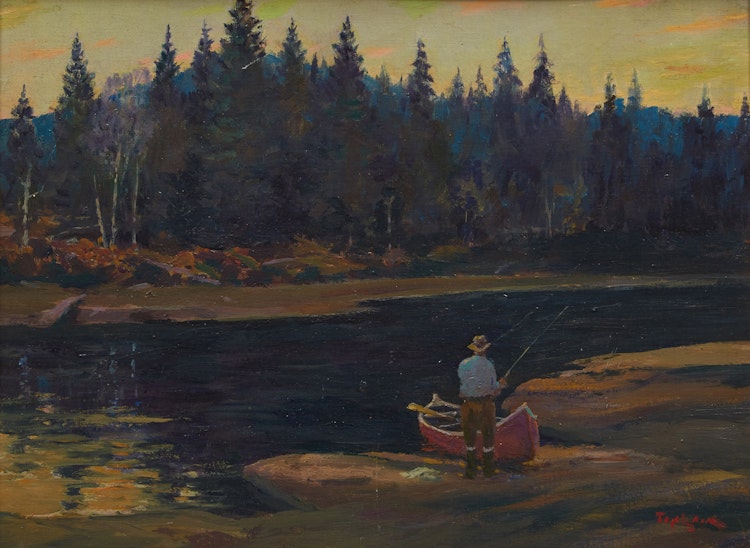Fisherman at Dusk by William Thurston Topham

Thurston Topham
Fisherman at Dusk
oil on canvas board
signed lower right; signed and titled on the reverse
12 x 16 ins ( 30.5 x 40.6 cms )
Auction Estimate: $600.00 - $800.00
Price Realized $944.00
Sale date: June 23rd 2020
Private Collection, Montreal
Share this item with your friends
William Thurston Topham
(1888 - 1966)
William Thurston Topham was born in Spondon, England, on July 23, 1888, to William Topham, a provision merchant, and Lucinda Mary Dale, who died when he was four years old. He first served as an apprentice to L.L. Goldie, a Derby architect, learning watercolour painting, interior decoration, and architectural design; however, hoping to become an artist, he took classes at the Derby Municipal School of Art in the evenings. In 1908 his aunt, Anne Topham, an English governess to Kaiser Wilhelm's daughter, invited him to Berlin, where he worked for the architects Schwitters and Bothke. Again he took evening classes, this time at the Arthur Lewin-Funcke School of Art, which was modelled on the Academie Julian in Paris. The following year he spent time in Paris and then joined H.H. Martyn Co. in Cheltenham, England. In 1911 he immigrated to Montreal, where he decorated interiors and designed period furniture for the Bromsgrove Guild.
Topham (documented as 5 foot 11 inches with blue eyes, brown hair, and an oval pigment patch on forehead) joined the First World War as a gunner and war artist. Although his duties included sketching panoramic views, he would work on his own paintings by moonlight. After two months he was exposed to gas, and he spent the next two years in medical facilities. The NGC acquired fifty of his Battle of the Somme drawings, and others were sold to magazines. They capture the often moonlit, muddy, and dismal lives of soldiers on the front. Once back in Montreal, he freelanced, creating illustrations, posters, and murals. Keen to establish himself as an artist, he joined the Beaver Hall Group and the Arts Club, where he taught sketching. Albert Laberge, in his review of the second Beaver Hall exhibition noted, "Mr. Topham is exhibiting an excellent still-life in vivid colours."
In 1925 Topham won first prize in a poster competition for the Canadian National Pilgrimage to Rome, and in 1928 a review in Toronto’s Star Weekly noted "that unbelievable moonlight which he has compounded by some mysterious alchemy" in his urban scenes and landscapes. In 1932 Topham caused a stir by submitting an article to the Star upbraiding a critic and defending his own work and that of A.Y. Jackson, Adrien Hebert, Edwin Holgate, and Adam Sherriff Scott: "The whole article reads as a veiled sneer: what slight praise is given to a few works is in most cases negatived immediately by further words of disparagement.... It does seem to me that the work of writing the article might with advantage have been allotted to a critic who possessed, at least, a little more knowledge, vision and appreciation of works of art. He won the AAM's Jessie Dow Prize at the Spring Exhibition twice. One of the winning works, Grey Day, Montreal, was selected for the Royal Suites at the Windsor Hotel during the visit of the royal family in 1939. By 1944, unhappy with the contemporary art selected for the Spring Exhibition, he joined several disgruntled artists in signing an open letter to the Star.
Topham was known for his small, colourful sketches in graphite, oil, watercolour, pastel, and acrylic. During the Depression he earned four hundred dollars painting a mural for the Mount Royal Chalet, part of a make-work project with his former Beaver Hall colleagues Hebert, Edwin Holgate, Robert Pilot — and nine others. In 1944 he painted Flight No. 3 Westbound, a mural depicting a Trans-Canada plane flying over the Rocky Mountains for the "Tea Wing" restaurant at Dorval Airport. His largest commission was eleven murals for the foyer of Montreal's Laurentian Hotel. Topham was a member of the Guild of Canadian Commercial Artists, a charter member of the Pen and Pencil Club, and president of the Independent Art Association of Montreal. In 1944 he joined ARCA. A review of landscape watercolours and oils exhibited at the Arts Club noted his "ability to convincingly depict water in violent motion. Topham died twenty years later in Montreal on March 11, 1966. He was married to Alice (Adelaide) Louise Burcombe and had two children.
Source: Evelyn Walters, The Beaver Hall Group and Its Legacy, Dundern Press, Toronto, 2017.

